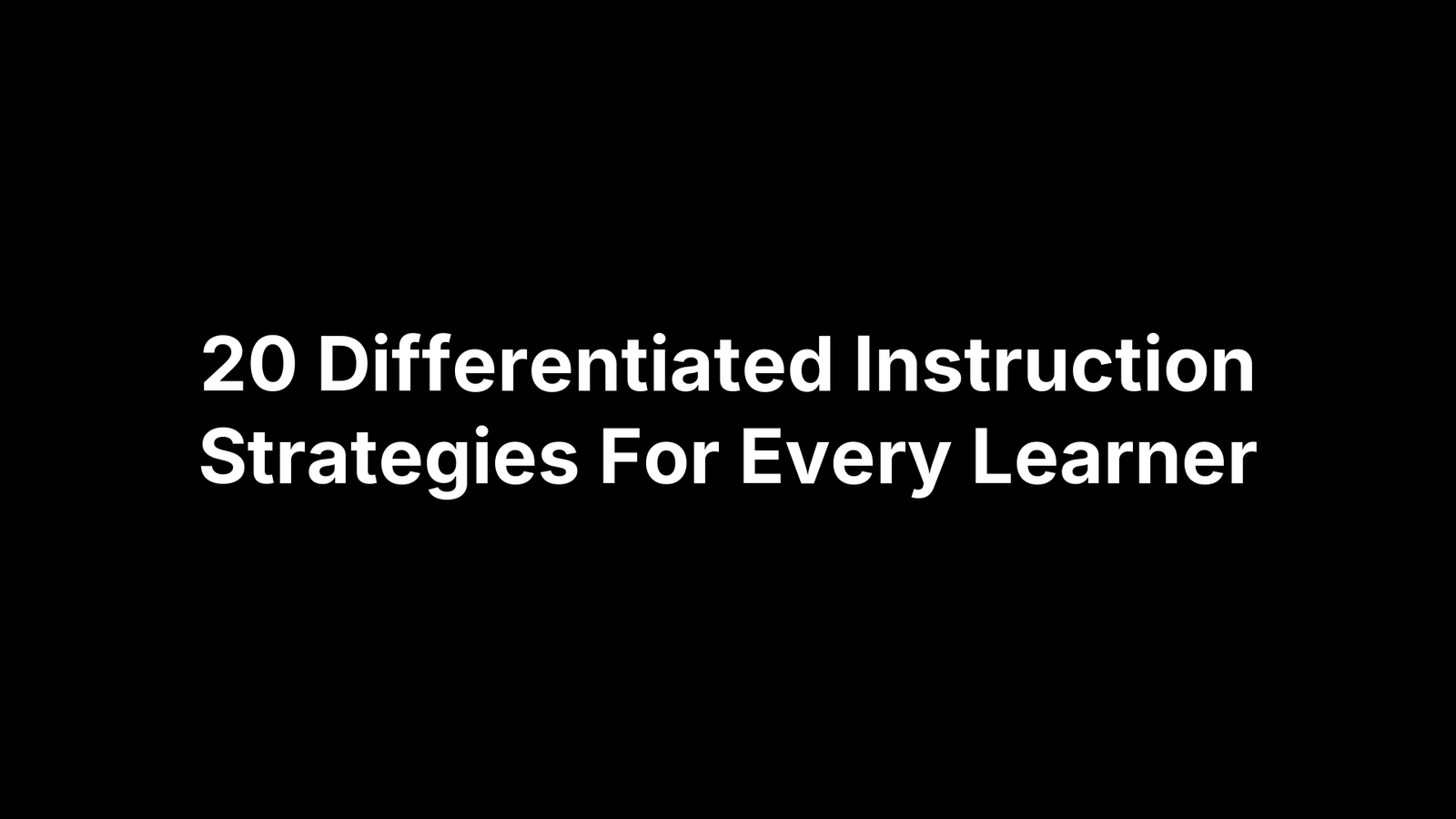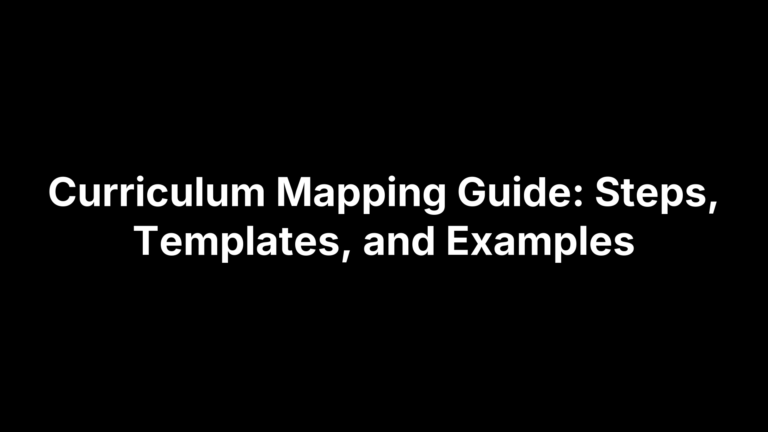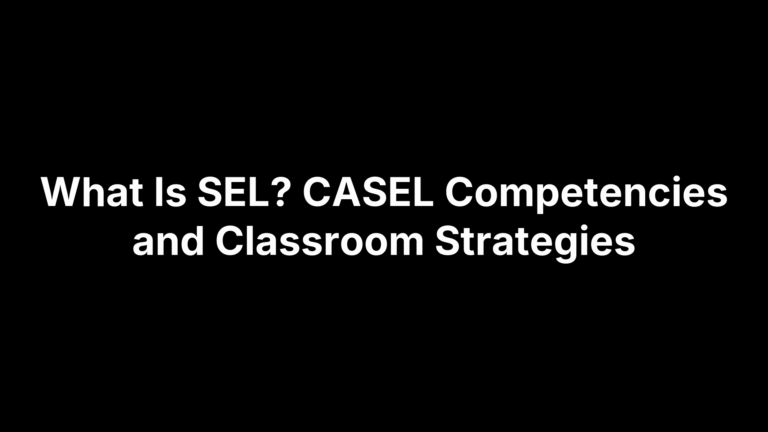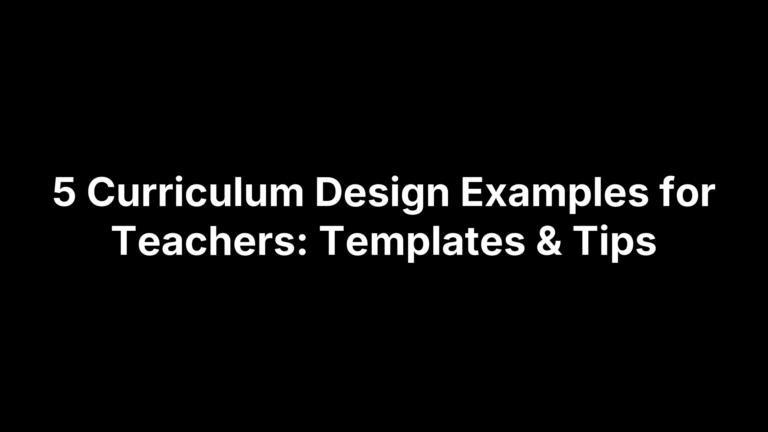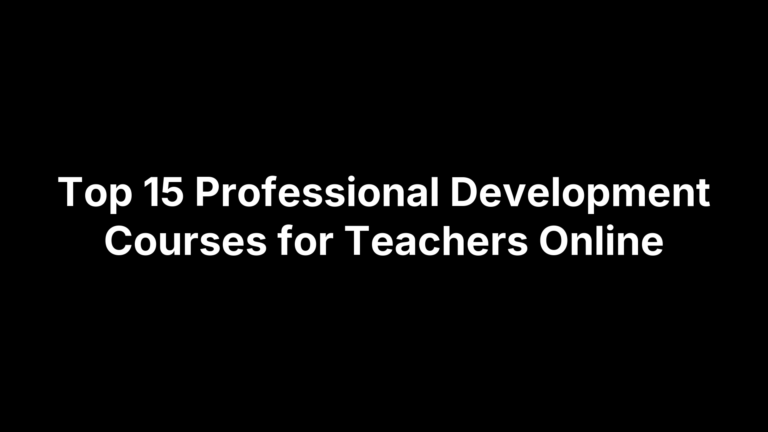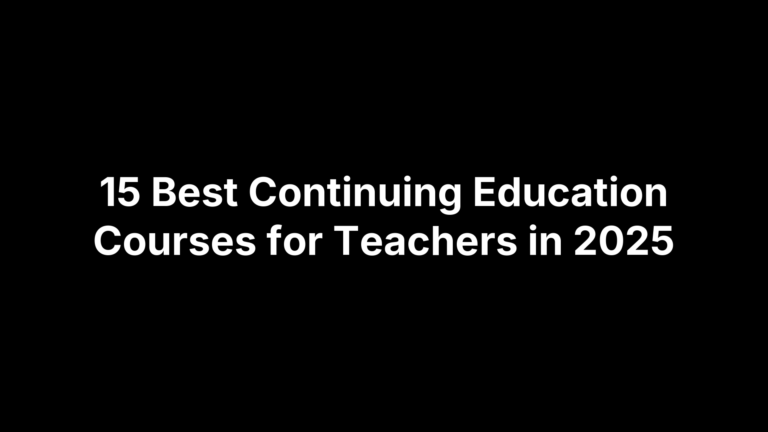Differentiated Instruction Strategies: Low-Prep Ideas for Immediate Use
Every class is a mixed bag of readiness levels, interests, and learning quirks, which means a single-track lesson plan invariably leaves someone behind. Differentiated instruction fixes that gap by tuning four levers—content, process, product, and environment—so each student can reach the same learning goal through a path that fits. If you’ve been hunting for practical, low-prep ways to make this adjustment without multiplying your workload, you’re in the right place.
Below you’ll find 20 classroom-tested strategies arranged from quick assessment moves to high-impact routines. Each one comes with step-by-step directions, real-class examples, and tips for multiple grade levels and subjects, so you can choose what works and use it tomorrow. Think of the list as a menu: pick two ideas to pilot this week, then circle back for more as your confidence grows. Let’s get started.
1. Use Pre-Assessments to Drive Instruction
What It Is and Why It Works
A pre-assessment is a quick diagnostic snapshot you give before a unit or skill block. It tells you what students already grasp, what misconceptions lurk, and where the true entry point should be. When you know the starting line, you can group flexibly, adjust pacing, and calibrate task complexity instead of guessing.
Quick Implementation Steps
- Launch with low-prep tools: one-question entrance ticket, K-W-L sticky chart, or a four-item Google Forms quiz.
- Collect responses in real time; project a bar graph or sort stickies by column.
- Spend five minutes labeling “Got it,” “Partial,” and “Need it” piles—those become your groups and mini-lesson targets.
- Jot next steps on a sticky; no elaborate spreadsheet required.
Differentiation Twists
- Highlight data with green, yellow, red dots so students see their zone at a glance.
- Have learners set a micro-goal (“move from yellow to green on fractions”) and revisit it during reflection time.
2. Flexible Grouping for Dynamic Collaboration
Fixed ability groups are outdated; students grow day by day. Flexible grouping reshuffles teams according to real-time evidence so everyone spends more minutes in the sweet spot of productive struggle.
Core Idea
Fluid groups form around readiness, interest, or learning profile rather than static test scores. Students might tackle a mini-lesson together one period and remix into passion cohorts the next.
How to Set It Up
- Deliver a brief whole-group hook (5 min).
- Use exit-slip data or a quick poll to sort students.
- Post group lists on the board and rotate after each formative checkpoint.
Classroom Management Tips
Assign rotating role cards—coach, scribe, reporter—to keep talk balanced. Prep “must-do/may-do” anchor tasks so early finishers stay busy while you conference with a targeted group.
3. Learning Stations That Target Multiple Modalities
Learning stations break a single lesson into bite-size experiences—each hitting a different sense—so students move, talk, and tinker toward the same goal.
Station Design Essentials
Plan three to five stations that hit visual, auditory, kinesthetic, and social modalities. Keep the learning target at every table, include self-checking cues, and cap tasks at ten minutes to maintain momentum.
Step-by-Step Guide
- Identify objective and success criteria.
- Match each modality to a distinct task.
- Gather materials in color-coded bins.
- Set timer and teach signal for rotation.
- Debrief with a 3-2-1 exit slip.
Example Station Rotation
Grade-8 ELA: ① vocabulary card sort with images, ② podcast clip for tone analysis, ③ peer quiz on Chromebooks, ④ mini-writing booth drafting a metaphor tweet.
4. Choice Boards to Empower Student Agency
A choice board is a nine-square “menu” of standards-aligned tasks that lets students decide how they will practice and show learning. By mixing modalities and challenge levels, it turns compliance into ownership—one of the simplest differentiated instruction strategies you can launch tomorrow.
Overview and Rationale
Giving learners multiple paths taps self-determination theory: autonomy + competence = motivation. When students pick tasks that fit their interests or confidence level, engagement rises and off-task behavior drops without extra policing.
Building an Effective Board
- Start with one clear objective; every square must address it.
- Tier difficulty horizontally (emerging → proficient → advanced) and vary product types vertically (creative, analytical, practical).
- Include at least one low-tech and one tech-enhanced option to honor access issues.
Assessment and Accountability
- Use a single-point rubric that works for any task: criteria in the middle, “exceeds” and “needs work” margins.
- Require a brief reflection—What did I choose and why?—to surface metacognition.
- Spot-check products mid-week so feedback, not grading, drives improvement.
5. Tiered Assignments for Varied Readiness Levels
Tiered assignments let every student chase the same standard but at a just-right level of complexity, preventing boredom for experts and overwhelm for beginners.
Concept Explained
You create several versions of one task that reach the same objective but vary in depth, scaffolds, and abstraction—think training wheels, regular bike, mountain bike.
Crafting Tiered Tasks
Draft a three-row template: Emerging row offers concrete prompts and sentence starters; Proficient row uses word problems; Advanced row adds open-ended transfer like designing a budget spreadsheet. Match each row to Bloom’s remember → create.
Avoiding Tracking Pitfalls
Let students self-select tiers anonymously with colored folders and encourage leveling-up mid-lesson; praise strategy use, not label, so groups stay fluid and stigma-free for all.
6. Curriculum Compacting for Advanced Learners
When students demonstrate mastery before a unit begins, reteaching them feels like punishment and drains class momentum.
What and Why
Curriculum compacting trims content an advanced learner already owns, opening time for deeper exploration or acceleration.
Implementation Steps
- Give a brief pre-test; scores ≥ 90 % trigger compacting.
- Mark mastered objectives and excuse related practice.
- Replace with an enrichment option: independent inquiry, accelerated online module, or peer coaching.
- Schedule quick weekly progress check.
Documentation
Use a one-page compacting form to share plan with parents and admins.
7. Tic-Tac-Toe Learning Menus
A Tic-Tac-Toe board turns assignment selection into a mini-game: complete any three tasks in a row, column, or diagonal to win.
Structure and Appeal
The game frame adds novelty, while the diagonal rule nudges students toward varied levels of thinking.
Designing the Grid
Place low, medium, high tasks across each row and column; balance creative, analytical, and practical products.
Sample Menu
Grade-7 Social Studies example:
- Storyboard the Boston Tea Party (visual).
- Design a political cartoon on taxation (analytical satire).
- Record a three-minute podcast explaining colonists’ grievances (auditory).
8. Task Cards for Targeted Practice
Task cards are palm-sized prompts that let students circulate, self-pace, and recheck answers, making them one of the quickest differentiated instruction strategies to deploy.
Why Task Cards Work
Movement plus micro-tasks keeps attention high while allowing you to target one skill per card.
Creation and Usage
- Format: prompt, workspace, QR code solution
- Run a “Scoot”: students rotate every 45 seconds
- Lay cards at centers for intervention or enrichment
Differentiation Ideas
- Color-code by difficulty; students pick their challenge
- Print hints or sentence stems on the back
- Record audio versions for readers who need support
9. Think-Pair-Share to Boost Participation
Think-Pair-Share is a routine that multiplies talk time and confidence for every student. By protecting silent thinking first, it levels the playing field—making it a low-prep staple among differentiated instruction strategies.
Strategy Snapshot
Students process a prompt alone, test ideas with a partner, then share highlights with the class. The three-part flow respects introverts while still surfacing diverse viewpoints.
Implementation Tips
Use a visible timer: Think 30 seconds, Pair 90, Share 2 minutes. Post accountable-talk stems (“I agree because…”) to guide dialogue. Circulate during the pair phase to eavesdrop on misconceptions worth spotlighting.
Variations
Write-Pair-Share uses notebooks; Pair-Square-Share merges two pairs into quads.
10. RAFT Writing (Role, Audience, Format, Topic)
RAFT reframes writing by having students select a Role, Audience, Format, and Topic—turning a one-size-fits-all prompt into a purposeful, audience-aware piece that feels more like storytelling than seatwork.
Why RAFT Supports Voice and Perspective
Assuming a character or object forces learners to process facts deeply, adjust tone for a real reader, and practice voice—boosting comprehension and engagement at the same time.
Designing RAFTs
Create a small matrix—3–4 options per column. Students mix choices or roll dice to decide their assignment. Add one high-challenge option so every learner meets the target at an appropriate stretch level.
Subject Examples
- Science: Diary entry from an electron orbiting a carbon atom
- History: Newspaper editorial by a Boston patriot in 1776
11. Jigsaw for Collaborative Expertise
Jigsaw makes every learner an expert and distributes responsibility evenly—an efficient, low-prep way to differentiate complex content.
Method Overview
Students master one chunk, then teach it to a re-mixed group.
Setup Sequence
- Assign chunks; form expert groups.
- Experts note essentials on template.
- Recombine into home teams; teach peers.
- Finish with class synthesis quiz or product.
Management Tips
- Limit phases to 10 minutes each.
- Give speaking chips for equal airtime.
- Station yourself as “coach” for stuck teams.
12. Socratic Seminar with Differentiated Roles
Nothing spurs higher-order thinking like a well-run Socratic Seminar. By assigning purposeful roles, you ensure every learner enters the circle with a clear job and an equal chance to speak.
Purpose
To shift inquiry ownership from teacher to students while practicing evidence-based reasoning, active listening, and respectful rebuttal.
Differentiation Moves
- Questioner: crafts three open-ended prompts pulled from the text
- Connector: links ideas to prior lessons or personal experience
- Summarizer: distills each exchange into a tweet-length takeaway
- Evidence Finder: cites page numbers to support or challenge claims
Assessment
Use a discussion map to log contributions and a single-point rubric for students’ quick self-reflection afterward.
13. Multimedia Instruction to Engage the Senses
Multimedia instruction blends words, images, sound, and hands-on clicks so the brain encodes ideas twice—verbally and visually—boosting recall and motivation.
Rationale
Dual-coding studies show that mixing media lifts comprehension, sustains attention, and reduces cognitive load for struggling readers.
Implementation
- Pair an infographic with a 90-second video to cement key terms.
- Embed a PhET simulation for small groups to test and tweak concepts in real time.
- Close with a captioned GIF recap students can revisit during homework.
Accessibility Considerations
Provide captions, alt text, and transcripts so every learner can access the lesson regardless of hearing, vision, or bandwidth limitations.
14. Interactive Journals and Reflective Logs
Interactive journals turn everyday notebooks into two-way conversations, capturing student thinking and giving you real-time insight into learning progress.
Why Reflection Matters
Writing about one’s process forces metacognition; studies show learners who self-explain remember concepts longer and transfer skills more readily.
Formats
Offer paper dialogue journals with teacher replies, shared Google Docs for threaded comments, or short voice notes for students who prefer speaking.
Prompt Ideas
Use rotating stems: “I used to think…”, “Now I know…”, “One question I have…”, plus an emoji mood check to track feelings.
15. Learning Contracts and Goal Setting
Learning contracts give students voice and choice by spelling out what they’ll learn, how, and the evidence needed for mastery. They’re perfect for independent study days or long project blocks.
Contract Components
- Standard-aligned goal
- Resource menu (texts, videos, tutors)
- Timeline with checkpoints
- Product + rubric
Launching Contracts
- Co-create a SMART goal in a quick conference.
- Agree on resources and deadlines; both sign.
- Store the contract in a shared folder.
Monitoring Progress
- Weekly 60-second status slip or digital check-in
- Peer buddy for feedback
- Micro-celebrations when checkpoints are met
- Teacher uses the data to adjust grouping or extend challenges
16. Scaffolded Graphic Organizers
Graphic organizers act like visual scaffolding, turning abstract ideas into shapes and lines students can manipulate.
Function
They chunk information, reduce cognitive load, and expose relationships that a wall of text hides—perfect for multilingual learners and anyone who thinks better in pictures.
Common Organizers
Keep a toolbox ready: Frayer Model for vocabulary, concept maps for cause-effect chains, sequence charts for timelines, and T-charts for quick comparisons.
Gradual Release
Start with teacher-made templates, then partially blank versions, and finally invite students to design their own organizers as meta-learning evidence of mastery.
17. Gamified Challenges and Badge Systems
Turning lessons into games taps students’ competitive spirit and need for instant feedback, making routine practice feel like a level-up quest instead of seatwork—one of the most engaging differentiated instruction strategies.
Why Gamification Motivates
Badges visualize growth, points trigger dopamine, and choice of quests supports autonomy—three pillars that boost persistence for all readiness levels.
Designing Classroom Games
- Award XP for mastery, not speed; unlock mini “boss battles” at each checkpoint.
- Rotate team and solo quests so collaboration and individual accountability stay balanced.
Tech or Low-Tech Options
Use Classcraft, Google Sheets, or a simple wall chart of sticker badges; keep offline tokens handy for screen-free days.
18. Technology & AI Tools for Personalized Learning
Digital platforms and AI algorithms now let us adjust pace, scaffolds, and feedback for each learner—without chaining you to the copy machine.
Role of EdTech in Differentiation
Real-time analytics flag who needs reteaching, adaptive paths stretch experts, and automation frees minutes for real conversation.
Tool Examples
- Adaptive math apps that auto-adjust difficulty
- Speech-to-text and text-to-speech tools
- Slide decks with alt-text for screen readers
- AI worksheet/quiz generators (our Differentiated Instruction Helper) to cut prep
Best Practices
- Vet privacy policies; no student data without parental consent
- Limit screen time with analog backups
- Pair any tech activity with reflection for deeper transfer
19. Alternative Assessments and Student-Choice Products
Traditional tests capture only a sliver of what students can do. Offering multiple product options honors diverse talents, increases buy-in, and supplies richer evidence for grading—an essential upgrade to any set of differentiated instruction strategies.
Why Products Matter
Self-selected formats align with Universal Design for Learning’s “multiple means of expression,” letting a shy artist or an eloquent podcaster both hit the same standard while showcasing strengths.
Product Menu
- Infographic explaining a scientific cycle
- Five-minute podcast or screencast lesson
- Dramatic skit reenacting a historical event
- Prototype or 3-D model solving a real problem
- Mini-documentary with primary-source clips
Rubric Design
Use a single-point rubric: criteria column lists the learning targets; “Above” and “Below” margins stay blank for feedback. Add one student-chosen criterion to promote ownership.
20. Learning Environment Tweaks for Comfort and Focus
Sometimes differentiation is as simple as rearranging chairs or tweaking routines. Small environmental shifts can remove hidden barriers and give brains the conditions they need to thrive.
Physical Space Adjustments
Clear traffic lanes prevent backpack collisions and distraction.
- Quiet nook with noise-canceling headphones for sensory-sensitive readers
- Standing desk cluster or wobble stools to channel restless energy
Emotional Climate
Positive language and visible praise make risk-taking feel safe for every learner.
- Sticky-note celebration wall for peer shout-outs
- “Yet” poster that reframes mistakes
Routine Supports
- Visual schedules on the whiteboard with icons for ELLs
- Color-coded supply bins so searching never derails focus
- Rotating “tech helper” and “materials manager” jobs to build ownership and free teacher time
Taking Differentiation Forward
Differentiated instruction is not an add-on; it’s the operating system that lets every learner run. As the 20 strategies above show, most moves boil down to thoughtful planning up front and responsive tweaks on the fly—adjustments to content, process, product, or environment that compound into sizable gains in mastery and motivation.
Pick two ideas—maybe a quick pre-assessment and a menu-style choice board—and pilot them this week. Watch for shifts in engagement, collect a dash of student feedback, and refine. Next week layer in another strategy. Over time the routines become second nature, and the achievement gap shrinks one intentional decision at a time.
Whenever you need inspiration or a time-saving boost, swing by The Cautiously Optimistic Teacher and try our free Differentiated Instruction Helper or browse fresh lesson resources. Your classroom is already diverse; with these tools in hand, your instruction can be, too.
